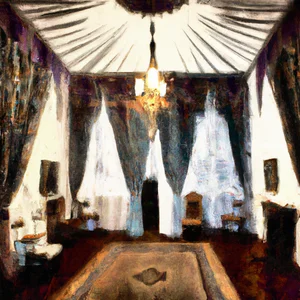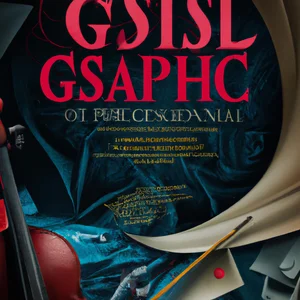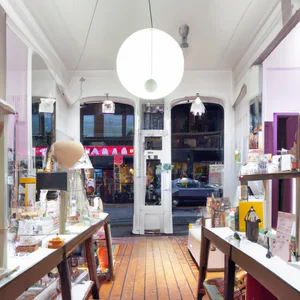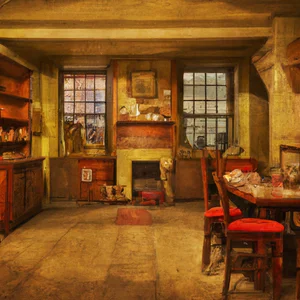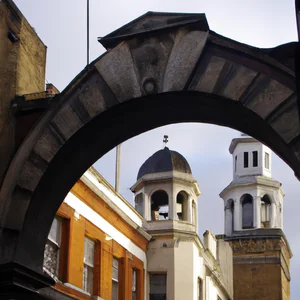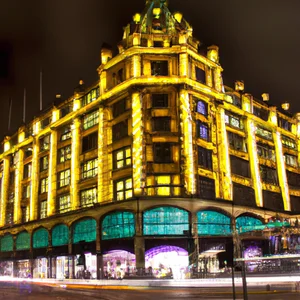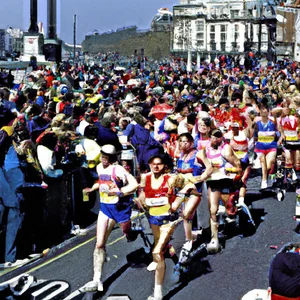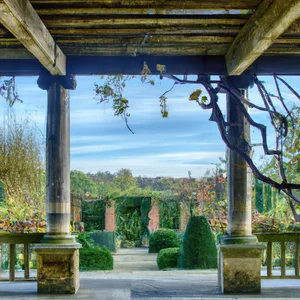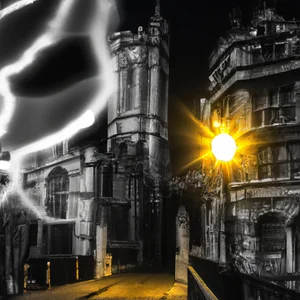Book your experience
Kensington: museums, parks and luxury shopping in the Royal Borough
Kensington is truly a place not to be missed! I tell you, it’s like a mix of cultures and styles that leaves you speechless. First of all, let’s talk about museums. There are a lot of them, and some are truly unmissable. The Natural History Museum, for example, is like a journey through time, with those dinosaurs that seem almost alive. I remember once I went there with a friend and we spent hours discovering every corner; we even got lost!
And then there are the parks, oh my! Kensington Gardens is a real gem. It’s like an oasis of peace amidst the chaos of the city. Imagine walking among the trees, perhaps with an ice cream in hand (yes, I know, a classic). And let’s not forget the famous Kensington Palace! There you can feel a bit like a princess, even just for a day.
And for those who love shopping, well, this is the right place to show off a little class. The luxury boutiques will make your head spin. Sure, it’s not like I can afford to buy everything, but it’s fun to take a look and dream a little, right? I think it’s an enriching experience, even just walking around and looking at the shop windows.
Overall, Kensington is a great place to spend a day. Whether you are an art enthusiast, a nature lover or a shopping fan, there is always something to do. In short, there are so many things to see and do that, at the end of the day, you will feel a bit like an explorer in a city that never ceases to surprise.
Discover the Natural History Museum in Kensington
An unforgettable experience
I still remember the first time I crossed the threshold of the Natural History Museum in Kensington. As I walked through the grand atrium, with its imposing dinosaur skeleton towering above me, I felt like a child in a magical world. The wonder at the beauty of nature, represented in every corner of the museum, is an experience that remains etched in the memory. Every time I visit this place, I discover something new: a temporary exhibition, a hidden corner, or simply a different lighting on a fossil I already knew.
Practical information
The Natural History Museum is easily accessible by tube, “South Kensington” stop. Entrance is free, but it is advisable to book in advance for special exhibitions. Hours are generally 10am to 5.50pm, but always check the official website for any updates or closures for special events. Don’t forget to check out the museum shop for unique and sustainable souvenirs.
An insider tip
A little secret that few know is the mineral room, which is located on the upper floor. Here, you can admire an extraordinary collection of gems and minerals from all over the world. It is often less crowded than other sections, giving you the opportunity to enjoy the beauty of the crystals in peace. If you’re lucky enough to visit on a weekday, you might even have the room to yourself!
Cultural and historical impact
The Natural History Museum is not just a place of learning, but a symbol of human curiosity and commitment to knowledge. Founded in 1881, the museum has played a crucial role in promoting science and conservation; an aspect that is more relevant today than ever, considering the environmental challenges we face. Its collections not only tell the story of the Earth, but also inspire future generations to care for our planet.
Sustainable tourism practices
The museum is actively pursuing sustainability practices, from reducing waste to promoting environmentally themed events. Participating in these initiatives is a great way to contribute to responsible tourism while exploring the richness of this cultural treasure.
A dream atmosphere
Imagine walking through the tunnels, surrounded by millions of years of natural history. The soft lighting and the scent of ancient wood create an almost mystical atmosphere. Each step brings you closer to a new story, a new discovery. It’s a sensory journey that invites you to reflect on our connection to the natural world.
An activity worth trying
Not to be missed is the “Wildlife Photographer of the Year” exhibition, which offers a unique and extraordinary perspective on animal life through the eye of talented photographers. If you are a nature and photography lover, this exhibition will leave you speechless!
Myths to dispel
A common misconception is that the museum is only for children. In reality, it offers content and exhibitions that attract visitors of all ages, from toddlers to adults. It is a place where science meets art, and every visitor can find something that stimulates their curiosity.
A final reflection
After visiting the Natural History Museum, we invite you to reflect on how vital it is to take care of our environment. What is your relationship with nature? This experience is not just a journey into the past, but an invitation to connect with the present and actively contribute to the protection of our planet. Kensington and its museum await you for an experience that goes beyond a simple visit: it is a journey into the heart of life itself.
Peaceful strolls in Kensington Gardens
A moment of calm in a vibrant city
I still remember the first time I set foot in Kensington Gardens. It was a spring morning, and the trees were in full bloom, the pink cherry petals dancing gently in the air. As I walked along the manicured paths, I realized that this corner of tranquility was the perfect refuge from the hubbub of London. Here, time seems to slow down, and the frenzy of the city fades away, giving way to an atmosphere of serenity and beauty.
Practical information
Kensington Gardens, which covers over 265 acres, is open to the public all year round. Entry is free, but some indoor attractions, such as Kensington Palace, may require a ticket. For an informed visit, I recommend consulting the official website of the gardens Royal Parks for any seasonal events or special activities.
An insider tip
While many visitors focus on the more famous areas, such as the Duck Pond, a true insider knows that the rose garden is a corner not to be missed. Here, in the summer months, a variety of blooming roses fill the air with an intoxicating scent and provide a picturesque backdrop perfect for a photo. It is the ideal place for a break with a good book or simply to contemplate natural beauty.
Cultural and historical impact
Kensington Gardens is not only a tourist attraction, but also an important part of London’s history. Originally designed in the 17th century, these gardens were a place of recreation for the royal family and are home to a number of historic monuments, such as the Memorial to Diana, Princess of Wales. Walking here is like strolling through a living chapter of English history, where every tree and flowerbed tells stories of times gone by.
Sustainability and responsible tourism
Kensington Gardens is also an example of sustainable tourism practices. The Royal Parks authority is committed to preserving these green spaces, promoting initiatives for biodiversity conservation and environmental education. During your visit, you may come across events that encourage recycling and sustainability, a perfect way to contribute to the well-being of the local environment.
Immersion in the atmosphere
Walking through the gardens, you might encounter street performers playing sweet tunes or families picnicking on the green grass. The birds chirp, the leaves they rustle and the air is refreshing, creating a symphony of sounds that fills the heart with joy. There is nothing more rejuvenating than sitting on a bench and watching the world go by, feeling life pulsate around you.
An activity worth trying
I recommend having a cup of tea at the nearby Orangerie, a charming café located within the gardens. Here, you can enjoy a delicious afternoon tea surrounded by elegant, historic surroundings, while watching visitors stroll by and the gardens bloom.
Myths to dispel
A common misconception is that Kensington Gardens is only for tourists. In fact, they are also a place loved by Londoners, who come here to relax and enjoy nature. This is a clear sign that, despite their popularity, they maintain an atmosphere of intimacy and community.
Final reflection
After exploring Kensington Gardens, I found myself reflecting on how important it is to find moments of tranquility in a busy life. We invite you to consider: What are your favorite spaces to reconnect with nature and yourself, even in such a vibrant city?
Luxury shopping on High Street Kensington
An experience that leaves its mark
My first visit to High Street Kensington was an experience I won’t soon forget. Walking along the street, surrounded by elegant boutiques and glittering shop windows, I felt transported to a world of luxury and refinement. I vividly remember stopping in front of a small jewelry shop, where an artisan was creating a unique piece by hand. This is the charm of High Street Kensington: a mix of high fashion and quality craftsmanship that tells stories of passion and creativity.
Practical information
High Street Kensington is easily accessible via the tube, with Kensington High Street station just a short walk from the top of the street. Here you will find luxury brands such as Harrods, Dior and Chanel, but also more accessible shops such as Zara and H&M. In addition, it is interesting to note that some stores offer personal shopping services, a treat for those looking for a tailor-made experience. For updates and special events, I recommend you visit the official Kensington and Chelsea website, where you will also find information on markets and special sales.
An insider tip
A well-kept secret is Kensington Market, a small market that opens every Saturday. Here you can find unique and vintage items, from handmade leather bags to handcrafted jewelry. It is the ideal place to find a souvenir that tells a story, far from the usual commercial chains.
Cultural and historical impact
High Street Kensington is not only a shopper’s paradise, it is also a place full of history. The street has been a commercial hub since the 19th century, helping to shape Kensington’s identity as one of London’s most elegant areas. Visitors can appreciate the historic architecture of the shops and cafes, which adds a touch of charm to the neighborhood.
Sustainability and responsible tourism
In recent years, many shops on High Street Kensington have adopted sustainable tourism practices. Brands like Reformation and Patagonia are committed to using eco-friendly materials and reducing waste. Choosing to purchase from these boutiques not only allows you to bring home a unique piece, but also contributes to more responsible business practices.
Soak up the atmosphere
Imagine strolling along the cobbled pavement, the scent of freshly roasted coffee mixing with the fresh London air. The laughter of children playing in nearby parks blends with the sound of rustling shopping bags, creating a vibrant and welcoming atmosphere. Every corner of High Street Kensington tells a story, and every shop is a chapter in a tale worth exploring.
Suggested activity
After a day of shopping, don’t miss afternoon tea at The Orangery, located in Kensington Gardens. Here, you can enjoy a selection of exquisite desserts and fine teas, in an environment that seems straight out of a fairy tale.
Myths to dispel
A common misconception is that High Street Kensington is exclusively for wealthy tourists. In fact, the street also offers affordable shopping and a variety of experiences for all budgets. Don’t let appearances fool you: you’ll find something special here, no matter your budget.
Final reflection
As you leave High Street Kensington, you ask yourself: what makes a truly meaningful purchase? Is it the brand, the price, or the story behind the item? In an increasingly consumer-oriented world, perhaps true wealth lies in finding pieces that speak to you and your experiences.
Exploring the Victoria and Albert Museum: art and design
A Personal Experience
I still remember the first time I crossed the threshold of the Victoria and Albert Museum (V&A). The light filtered through huge colored windows, creating an almost magical atmosphere. An exhibition of oriental ceramics captivated me, but it was the fashion section that really captured my heart. Walking among beautifully preserved historical clothing and accessories, I felt a connection to the stories of those who had worn them. The V&A is not just a museum, it is a journey through human creativity.
Practical Information
Located in South Kensington, the V&A is easily accessible by tube (the nearest stop is South Kensington). Entrance is free, but some temporary exhibitions may require a ticket. It is advisable to check the official website Victoria and Albert Museum for updated opening hours and current exhibitions. Don’t forget to visit the museum café, which offers a selection of culinary delights in a charming setting.
Insider advice
If you want to avoid the crowds, consider visiting the V&A during the late afternoon on weekdays. A little trick I discovered is to use the escalators instead of the elevator: not only do you avoid the queues, but you also have the chance to admire works of art hanging along the corridors.
Cultural and Historical Impact
Founded in 1852, the Victoria and Albert Museum is a tribute to the history of art and design. It houses a collection of over 2.3 million objects, ranging from medieval sculpture to contemporary works. This museum has played a vital role in shaping art education in Britain and continues to be a point of reference for designers and artists from around the world.
Sustainability and Responsible Tourism
The V&A is committed to sustainability practices, such as recycling and the use of eco-friendly materials in its exhibitions. During your visit, I invite you to explore the museum garden, a quiet place where you can reflect and relax, away from the hustle and bustle of the city.
Unique Atmosphere
Entering the V&A is like entering a parallel dimension where time stops and beauty reigns supreme. The walls are adorned with works of art that tell stories of past cultures and eras. Even the architectural details, with their splendid mosaics and sculptures, invite deep contemplation.
Recommended Activity
Don’t miss the opportunity to participate in one of the creative workshops that the museum offers regularly. These events are a fantastic way to express your creativity and learn new styles and techniques, supported by industry experts.
Myths and Misconceptions
A common misconception is that the V&A is only for art enthusiasts. In fact, the museum offers something for everyone: there are sections dedicated to technology, industrial design and even photography. It’s a place where generations can connect and discover together.
Final reflection
After visiting the V&A, I asked myself: how do art and design influence our daily lives? The museum is not just a place of exhibition, but an invitation to reflect on how creativity permeates every aspect of our existence . I invite you to visit it and discover what story it will tell you.
Unique culinary experiences in local markets
A journey through the flavors of Kensington
I still remember the first time I visited Portobello Road Market. As I walked among the stalls, the scent of exotic spices and freshly baked sweets enveloped me like a hug. The liveliness of the market, with its colors and sounds, transported me into an unforgettable sensory experience. Every corner seemed to tell a story, and every taste was a journey into the heart of London culture.
Practical and up-to-date information
Portobello Market is open every day, but Saturday is the highlight, when the famous flea fair takes place. It is easily accessible by tube, getting off at the Notting Hill Gate stop. Don’t forget to taste some of the local delicacies, such as the famous scotch eggs or baklava sweets sold by Turkish vendors. Plus, the market is a great place to discover fresh produce, artisan cheeses and freshly prepared dishes.
An insider tip
A secret that few know is that, in addition to the main market, there are small culinary gems in the side alleys. Don’t miss the opportunity to visit the Wild Food Café, a corner that offers creative and healthy vegan dishes. Here, every dish is a work of art, prepared with fresh, sustainable ingredients.
Cultural and historical impact
Kensington is a melting pot of cultures, and the local markets are the perfect representation of this. Each tasting is a reflection of the different culinary traditions that have intertwined over the years. The history of Portobello Market dates back to the 19th century and, since then, it has continued to evolve, becoming a symbol of London not only for shopping, but also for gastronomy.
Sustainable tourism practices
Many of the vendors at local markets follow sustainable farming practices and use ethically sourced ingredients. Choosing to eat in these places not only supports the local economy, but also the environment. It’s a perfect way to travel responsibly, contributing to a community that values quality and sustainability.
Soak up the atmosphere
Imagine enjoying a delicious fish and chips while listening to the tunes of a street musician playing a nostalgic tune. Or sip afternoon tea in a cozy cafe, surrounded by local artwork. These experiences make Kensington a place where food becomes a means to connect with culture and community.
Activities to try
I recommend taking a food tour of the local markets. There are several options available, such as London Food Tours, which will take you to discover the best hidden dishes and restaurants. It’s an opportunity to taste real London cuisine and meet local producers.
Myths and misconceptions
A common misconception is that local markets are only for tourists. In fact, Londoners regularly frequent these places to shop and socialise. It’s an authentic experience that will make you feel part of the community.
A personal reflection
When I think about dining experiences in Kensington Markets, I wonder: what stories lie behind each dish? Every bite is an invitation to explore not only the gastronomy, but also the culture and traditions that make this corner of London so unique . What are you waiting for to discover all this?
A hidden corner: Kensington’s secret garden
An incredible personal discovery
I still remember the day I discovered the Secret Kensington Garden. After visiting the Natural History Museum, I found myself wandering the quiet streets of Kensington, my mind full of dinosaurs and shiny minerals. Following a small path, I arrived at a wooden door hidden by thick vegetation. With some hesitation, I opened it and was greeted by a world of tranquility: a lovely garden, away from the hustle and bustle of the city. It was as if time had stopped.
Practical information
The secret garden, officially known as Kensington Roof Gardens, is open to the public during daylight hours. Located on the seventh floor of a building on High Street Kensington, it offers breathtaking panoramic views of London, along with a wide variety of plants and flowers. Entry is generally free, but I recommend checking the official website for any special events or access restrictions: Kensington Roof Gardens.
An insider tip
Here’s a secret that few people know: If you visit the garden during the week, you can find quiet corners to sit and relax, away from the weekend crowds. Also, don’t forget to bring a book with you; there are benches scattered throughout the garden, perfect for immersive reading surrounded by nature.
A cultural treasure
The garden is not only a place of natural beauty, but also has a rich history. Created in the 1930s, it was designed to provide a haven of peace for Londoners. The gardens have been used in the past for social and cultural events, helping to keep alive the tradition of green spaces in the British capital. This corner of Kensington represents a perfect fusion of nature and architecture, exemplifying the importance of green spaces in urban life.
Sustainability and responsible tourism
The garden is managed with sustainability practices in mind. The developers are committed to using local plants and promoting biodiversity, making this space not only a place of beauty, but also an example of how tourism can be responsible. Each visit supports an initiative that encourages nature conservation in an urban context.
Immersion in the atmosphere
Walking among the flower-filled paths and glittering lakes, it’s impossible not to feel transported to another world. The melodies of the birds and the scent of the flowers create a symphony of sensations that envelop visitors. The colorful flowerbeds and exotic plants provide a stunning visual experience, making the garden an ideal place to take photographs that capture the beauty of Kensington.
An activity not to be missed
Don’t miss the chance to attend one of the gardening workshops held regularly in the garden. These events offer the chance to learn from expert gardeners and immerse yourself in London’s gardening culture, taking away not only new knowledge, but also a little green souvenir.
Myths to dispel
A common misconception is that secret gardens are reserved only for a privileged few. In reality, these spaces are open to all and represent an opportunity to discover lesser-known sides of London. Don’t be fooled by the idea that only tourists have access to these hidden corners; they are for anyone who wants to explore the beauty of the capital.
A final reflection
After my visit to the secret garden, I asked myself: how many other hidden wonders are there in the places we take for granted? Visiting the garden is not just a way to contemplate the beauty, but an invitation to discover and appreciate the little corners of the world that can, unexpectedly, enrich our lives. If you find yourself in London, give yourself time to lose yourself in this corner of paradise.
The little-known history of Kensington Palace
A personal memory
I still remember the first time I visited Kensington Palace: the fresh morning air, the scent of the flowers in the gardens and the grandeur of that palace that told stories of monarchs and past eras. As I walked along its elegant rooms, I was struck by a detail: the room of Diana, Princess of Wales, where the soft colors and the simplicity of the furnishings conveyed a sense of intimacy and humanity, in stark contrast to the public image of life her. This palace, once the residence of kings and queens, is a place that holds fascinating secrets and little-known stories.
Practical information
Located in the heart of Kensington Gardens, Kensington Palace is easily accessible by tube, getting off at the High Street Kensington or Notting Hill Gate stop. It is advisable to book tickets online, especially during the tourist season, to avoid long queues. Guided tours are available and offer insight into the stories behind each room, with expert guides ready to reveal fascinating anecdotes.
An insider tip
A secret that few tourists know is that the palace also houses a lovely café in its courtyard, where you can sip afternoon tea surrounded by a regal atmosphere. Order a typical English dessert and enjoy the view of the gardens while listening to the birds singing: it is an experience that enriches the visit and offers a moment of reflection.
Cultural and historical impact
Built in 1605, Kensington Palace has seen numerous English monarchs pass by, from William III and Mary II to Victoria, whose life and reign are inextricably linked to this place. Each room tells a story, and the beauty of the surrounding gardens reflects the importance of the palace as a center of social and cultural life. The architecture, with its distinctive styles, is a true journey through the centuries.
Sustainability and responsible tourism
Kensington Palace is also committed to sustainability, using eco-friendly practices in the maintenance of its gardens and encouraging visitors to respect the environment. During your visit, take part in a sustainable gardening workshop, where you can learn techniques for growing plants responsibly.
Soak up the atmosphere
Imagine walking in Kensington Gardens, surrounded by flower beds and ancient trees, while the sun filters through the foliage. The palace, with its imposing facades and architectural details, stands as a silent witness to centuries of history. Every corner of the garden has a story to tell, and the air is filled with a sense of wonder.
An experience not to be missed
Don’t miss the opportunity to attend one of the temporary exhibitions inside the palace, where contemporary artists reinterpret history in surprising ways. These exhibitions offer a fresh and stimulating vision, making Kensington Palace a meeting place between past and present.
Myths and misconceptions
A common misconception is that Kensington Palace is just a place for tourists. In fact, it’s a vital part of London’s cultural life, with events and activities also engaging residents. It is a place where history is intertwined with daily life, and anyone can find a piece of themselves in the stories that these walls have to tell.
A final reflection
Kensington Palace is not just a historic residence; it is a place where the past and present meet, where every room and garden has a voice waiting to be heard. Which story will strike you most during your visit?
Sustainability and responsible tourism: local initiatives in Kensington
A personal experience
I remember my first trip to Kensington, when, walking through the beautiful streets of the neighborhood, I came across a small local producers’ market. The bright colors of fresh vegetables, the smell of freshly baked bread and the lively conversations among the vendors created a vibrant atmosphere. It was at that moment that I realized how important it was to support local initiatives and contribute to responsible tourism, a value that Kensington embraces with enthusiasm.
Local initiatives for sustainable tourism
Kensington is not only a place of beauty and culture, but it is also a model of sustainability. Several venues and organizations are working to promote eco-friendly practices. For example, the Kensington Sustainability Group has launched initiatives to reduce waste and promote the use of recyclable materials in restaurants and shops. Additionally, many venues now offer plant-based and organic options, reflecting a growing environmental awareness among consumers.
Insider tip
If you want an authentic and sustainable experience, visit the Kensington Farmers’ Market which takes place every Sunday. Here you can meet the producers directly, buy fresh products and support the local economy. A little-known tip: ask sellers to tell you the story of their products, they will often share fascinating anecdotes that will enrich your experience.
The cultural impact of Kensington
Kensington’s strong commitment to sustainability isn’t just a matter of fashion; it is rooted in the history of the neighborhood. Since the time of Queen Victoria, the area has been a hub of innovation, and today continues to promote a responsible approach to tourism. Raising awareness of sustainability has also led to greater appreciation of cultural heritage, making each visit an opportunity to learn and reflect.
Responsible tourism practices
Taking guided tours that emphasize sustainability, such as those organized by EcoLondon Tours, is a great way to explore Kensington. These tours will not only take you to discover the iconic places of the neighborhood, but will also provide you with information on the eco-friendly practices adopted by the residents.
A walk in the gardens of the future
Imagine walking in Kensington Gardens, surrounded by ancient trees and large expanses of greenery. Here, respect for the environment is evident: the gardens are maintained with sustainable gardening techniques, and often host events focused on biodiversity. A good idea is to join one of the guided walks that focus on the local flora and fauna.
A myth to dispel
A common misconception is that sustainable tourism requires sacrifices in comfort and experience. In fact, Kensington proves that it is possible to enjoy a luxurious stay without compromising the environment. In fact, many luxury hotels in the neighborhood are implementing sustainable practices, such as using renewable energy and reducing waste.
Final reflection
In a rapidly changing world, responsible tourism in Kensington offers a unique opportunity to immerse yourself in local culture while doing your part to preserve the planet. Have you ever wondered how your travel choices can affect the environment? Kensington is proof that every small gesture counts, and every visit can be a step towards a more sustainable future.
Unmissable cultural events in the Royal Borough
When I think of Kensington, I can’t help but remember the time I attended a cultural festival in the heart of the Royal Borough. It was a sunny day, and the streets were alive with street performers, musicians and stalls offering culinary delights from every corner of the world. The atmosphere was contagious, and I felt like I was part of something very special, a mosaic of cultures intertwined in a vibrant embrace.
Cultural experiences not to be missed
The Royal Borough of Kensington and Chelsea hosts cultural events ranging from contemporary art festivals to culinary celebrations, making it a pulsating hub of creativity. Every year, events such as the Chelsea Flower Show and the Notting Hill Carnival attract visitors from all over the world, offering a great opportunity to immerse yourself in local traditions. Don’t forget to check the calendar of events on the borough’s official website to find out what’s on during your visit.
Insider tips
One piece of advice only a true Londoner could give you is to look for less publicized events, such as poetry nights at The Tabernacle or live music concerts in local pubs. These events offer an authentic experience and allow you to interact with the community. Furthermore, you can always find pop-up events in local markets, where artists and creatives present their works in an informal way.
A profound cultural impact
Kensington is much more than just a tourist spot; it is a place where history and culture come together. The presence of institutions such as the Victoria and Albert Museum and the Natural History Museum is not accidental. These places not only celebrate the past, but also act as platforms for modern events, influencing London’s cultural scene in unexpected ways.
Sustainable tourism practices
When attending local events, try to support initiatives that promote sustainability. Many festivals now integrate eco-friendly practices, such as the use of biodegradable materials and the promotion of farm-to-table foods. This not only reduces environmental impact, but also supports small local businesses.
The atmosphere that envelops you
Imagine walking through the stalls of a market, the scent of spices and the sound of music filling the air. Every encounter, every laugh shared with strangers, makes you feel part of a larger community. It is an opportunity to discover not only art and culture, but also the human warmth that characterizes Kensington.
An activity worth trying
Don’t miss the opportunity to visit Kensington Palace during a special event, such as the summer opening evenings, where the gardens come alive with artistic performances and live music. It’s a beautiful way to join in the celebration of culture in a historical context.
Myths to dispel
A common misconception is that cultural events in Kensington are reserved only for wealthy tourists. In fact, many of these events are free or low-cost, making them accessible to everyone. The important thing is to be open to new experiences and ready to discover everything this neighborhood has to offer.
Final reflection
Kensington is not just a place to visit; it’s an experience worth living. What cultural event would you like to explore? Book your trip and prepare to be surprised by everything this charming neighborhood has in store for you!
Living like a Londoner: living room tips
A Personal Experience
During my first stay in London, I vividly remember the moment I abandoned the conventional tourist routes and decided to explore Kensington like a true Londoner. Hidden among the elegant streets and well-kept gardens, I discovered cafes crowded with residents and local markets that tell stories different from those of the more famous attractions. That day taught me that the beating heart of London beats not only in the monuments, but also in small daily experiences.
Practical Information
To live like a Londoner, start with a walk around the neighborhood. The streets of Kensington are full of charm, and one of my favorite areas is around Kensington High Street, easily reachable by tube (High Street Kensington station). Don’t forget to visit the Kensington Church Street market on Saturdays, where you can find antique dealers and small shops selling unique items. For updated timetables, check the market’s official website or social media pages.
Unconventional Advice
A tip that only locals know is to visit small hidden parks and gardens, such as Kensington Roof Gardens. This green space, located above a commercial building, offers breathtaking views of the city and a lovely atmosphere for a picnic. Access is free, but it is advisable to check seasonal openings.
Cultural Impact
Kensington is a corner that has seen the passing of centuries, reflecting the evolution of London culture. From noble residences to trendy modern cafés, every corner tells a story. Living like a Londoner also means appreciating these historical and cultural nuances, which make the neighborhood unique.
Sustainable Tourism Practices
In this era of growing environmental awareness, many venues are adopting more sustainable practices. For example, many cafes in Kensington use organic and locally sourced ingredients. Choosing to eat at restaurants that follow these guidelines not only supports the local economy, but also helps preserve the environment.
Atmosphere of the Place
Imagine walking along the streets of Kensington, surrounded by elegant Victorian buildings and flower gardens. The air is filled with the scent of freshly roasted coffee and freshly baked pastries. Londoners hurry with their takeaway coffees, while children play in the parks. Every corner invites you to stop and observe, to immerse yourself in the daily life of this fascinating neighborhood.
Recommended Activity
Try taking part in a local cooking workshop, where you can learn to prepare typical British dishes. There are many options in Kensington, and these experiences will allow you to learn more about the city’s food culture while sharing a meal with the locals.
Myths to dispel
A common misconception is that living like a Londoner means spending a fortune. In fact, there are many affordable options: from street markets to public parks, the city offers incredible experiences without having to break the bank.
Final reflection
As you leave Kensington, we invite you to reflect on how each trip can become an opportunity to immerse yourself in local culture. What’s your idea of living like a Londoner? You will discover that the most precious memories often arise from the most authentic encounters.

 Architecture and Design
Architecture and Design Cities and Regions
Cities and Regions Culture and History
Culture and History Events and Festivals
Events and Festivals Fashion and Shopping
Fashion and Shopping Food and Wine
Food and Wine Nature and Adventure
Nature and Adventure Unique Experiences
Unique Experiences


















